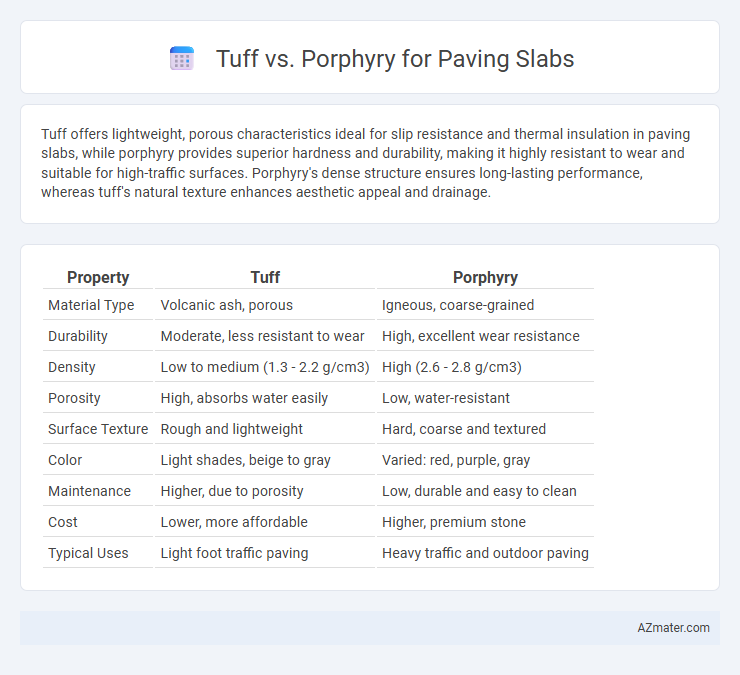Tuff offers lightweight, porous characteristics ideal for slip resistance and thermal insulation in paving slabs, while porphyry provides superior hardness and durability, making it highly resistant to wear and suitable for high-traffic surfaces. Porphyry's dense structure ensures long-lasting performance, whereas tuff's natural texture enhances aesthetic appeal and drainage.
Table of Comparison
| Property | Tuff | Porphyry |
|---|---|---|
| Material Type | Volcanic ash, porous | Igneous, coarse-grained |
| Durability | Moderate, less resistant to wear | High, excellent wear resistance |
| Density | Low to medium (1.3 - 2.2 g/cm3) | High (2.6 - 2.8 g/cm3) |
| Porosity | High, absorbs water easily | Low, water-resistant |
| Surface Texture | Rough and lightweight | Hard, coarse and textured |
| Color | Light shades, beige to gray | Varied: red, purple, gray |
| Maintenance | Higher, due to porosity | Low, durable and easy to clean |
| Cost | Lower, more affordable | Higher, premium stone |
| Typical Uses | Light foot traffic paving | Heavy traffic and outdoor paving |
Introduction to Tuff and Porphyry
Tuff is a volcanic rock formed from consolidated volcanic ash, characterized by its lightweight, porous texture and natural ability to weather evenly, making it a popular choice for paving slabs in historic and rustic settings. Porphyry, an igneous rock with large, distinctive crystals embedded in a fine-grained matrix, offers exceptional durability, slip resistance, and a rich color palette, often used in urban paving for its strength and aesthetic appeal. Both materials balance natural beauty with functional performance, but porphyry's superior hardness and abrasion resistance typically make it more suitable for high-traffic areas.
Geological Origins and Formation
Tuff originates from volcanic ash ejected during explosive eruptions, rapidly compacting into a lightweight, porous rock ideal for paving slabs with natural insulation properties. Porphyry forms through slow cooling of magma deep within the Earth's crust, producing large, embedded crystals in a fine-grained matrix, resulting in a dense, durable stone favored for high-traffic paving. The distinct geological formation processes directly influence the material hardness, texture, and weather resistance of tuff and porphyry paving slabs.
Physical Properties Comparison
Tuff exhibits lower density and compressive strength compared to porphyry, making it lighter but less durable under heavy loads, while porphyry's high hardness and abrasion resistance provide superior longevity for paving slabs. Porphyry's low porosity enhances resistance to water absorption and freeze-thaw cycles, whereas tuff's higher porosity may lead to increased weathering in harsh climates. The thermal conductivity of porphyry allows it to handle temperature fluctuations more effectively, promoting greater overall slab stability and performance.
Aesthetic Differences and Color Range
Tuff paving slabs offer a natural, rustic appearance with a porous texture and earthy tones ranging from soft greys to warm browns, creating a warm and inviting ambiance. Porphyry slabs feature a dense, crystalline structure with a polished surface, displaying vibrant colors such as reds, purples, and greens, ideal for striking architectural statements. The choice between Tuff and Porphyry ultimately hinges on desired visual impact, with Tuff providing subtle, organic aesthetics and Porphyry delivering bold, colorful sophistication.
Durability and Weather Resistance
Tuff exhibits moderate durability and weather resistance, making it suitable for mild climates but prone to erosion and surface wear under harsh weather conditions. Porphyry is highly durable and exhibits superior weather resistance due to its dense, igneous composition, making it ideal for high-traffic outdoor paving slabs exposed to freeze-thaw cycles and heavy rainfall. Porphyry's resistance to abrasion and chemical degradation significantly outperforms tuff, ensuring longer-lasting pavement surfaces.
Slip Resistance and Surface Texture
Tuff offers excellent slip resistance due to its naturally rough and porous surface texture, making it ideal for paving slabs in wet or high-traffic areas. Porphyry, with its dense and fine-grained crystalline structure, provides a smoother finish but retains good slip resistance when properly textured through bush hammering or thermal treatments. Selecting between tuff and porphyry depends on desired surface roughness and safety requirements for outdoor paving applications.
Maintenance and Cleaning Requirements
Tuff paving slabs require less frequent maintenance due to their natural durability and resistance to staining, making them ideal for outdoor areas with moderate foot traffic. Porphyry slabs demand more regular cleaning and sealing to preserve their polished surface and prevent moss or algae buildup, especially in damp environments. Both materials benefit from routine sweeping and occasional pressure washing to maintain their aesthetic appeal and longevity.
Cost and Availability in the Market
Tuff offers a more affordable option for paving slabs due to its widespread availability and lower quarrying costs, making it suitable for budget-conscious projects. Porphyry, with its dense, durable composition and limited quarry sources, commands a higher price but provides superior longevity and aesthetic appeal. Market availability for Porphyry is restricted compared to Tuff, impacting lead times and overall project scheduling.
Environmental Impact and Sustainability
Porphyry paving slabs exhibit exceptional durability and require minimal maintenance, resulting in a longer lifespan and reduced replacement frequency that lowers environmental impact over time. Tuff paving slabs, being softer volcanic rock, demand less energy-intensive quarrying and processing, contributing to a smaller carbon footprint during production compared to harder stones. Both materials' sustainability depends significantly on local sourcing to reduce transportation emissions and on the possibility of recycling or repurposing slabs at the end of their use cycle.
Best Use Cases for Paving Slabs
Tuff is ideal for paving slabs in low-traffic garden paths and decorative outdoor areas due to its lightweight and softer texture, providing ease of cutting and aesthetic appeal. Porphyry, known for its durability and high resistance to wear and weathering, is best suited for heavy-traffic urban pavements, driveways, and public plazas requiring long-term performance. Selecting Porphyry ensures superior strength and longevity, while Tuff offers cost-effective options for light-duty paving with natural stone aesthetics.

Infographic: Tuff vs Porphyry for Paving Slab
 azmater.com
azmater.com